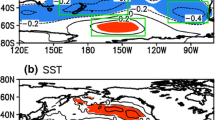Abstract
This study uses the Climate Forecast System Reanalysis (CFSR) to investigate the responses of the Southern Hemisphere (SH) extratropical climate to two types of El Niño-Southern Oscillation (ENSO)—the eastern Pacific (EP) type and the central Pacific (CP) type in different seasons. The responses are denoted by the anomalies of climate variables associated with one-standard-deviation increase in the Niño3 or Niño4 index. The results show that in austral spring the differences in the ENSO-related anomaly (ERA) patterns of atmospheric circulation between the EP ENSO period (1979–1998) and CP ENSO period (1999–2010) are mainly associated with the change in the ENSO-PSA2 relationship. Such differences affect the ERA fields of surface air temperature and mixed layer temperature, and finally result in significant differences in sea-ice concentration anomalies in the Atlantic sector. In austral summer, significant correlation exists between the variations of SAM and both of the variations of Niño3 and Niño4 in 1979–1998, while the correlation between SAM and Niño4 disappears in 1999–2010. For all seasons, the strength of the climate ERAs depend on if there are close relationship between ENSO and the major climate variation modes of the SH extratropics. For the climate variables, the ERA patterns of surface air temperature are generally controlled by surface wind anomalies and mirrored by the mixed layer temperature anomalies. The mixed layer depth anomalies are primarily modulated by surface heat flux anomalies and occasionally by anomalous wind. There are strikingly strong anomalies of surface heat flux in the autumn of 1979–1998 related to the Niño3 variation, the period when there is only significant correlation between ENSO and PSA2. There are no evidence that the SH extratropical climate variability induced by Niño3 variations are stronger in the EP-ENSO period, and that variability induced by Niño4 variations are stronger in the CP-ENSO period.
Similar content being viewed by others
References
Ciasto L M, Simpkins G, England M H. 2015. Teleconnections between Tropical Pacific SST anomalies and extratropical southern hemisphere climate. Journal of Climate, 28(1): 56–65, doi: https://doi.org/10.1175/JCLI-D-14-00438.1
Fogt R L, Bromwich D H. 2006. Decadal variability of the ENSO tele-connection to the high-latitude South Pacific governed by coupling with the Southern Annular Mode. Journal of Climate, 19(6): 979–997, doi: https://doi.org/10.1175/JCLI3671.1
Fogt R L, Bromwich D H, Hines K M. 2011. Understanding the SAM influence on the South Pacific ENSO teleconnection. Climate Dynamics, 36(7-8): 1555–1576, doi: https://doi.org/10.1007/s00382-010-0905-0
Gong Tingting, Feldstein S B, Luo Dehai. 2013. A simple GCM study on the Relationship between ENSO and the Southern Annular Mode. Journal of the Atmospheric Sciences, 70(6): 1821–1832
Gupta A S, England M H. 2006. Coupled ocean-atmosphere-ice response to variations in the southern annular mode. Journal and Climate, 19(18): 4457–4486, doi: https://doi.org/10.1175/JCLI3843.1
Kao H Y, Yu Jinyi. 2009. Contrasting eastern-pacific and central-pacific types of ENSO. Journal of Climate, 22(3): 615–632, doi: https://doi.org/10.1175/2008JCLI2309.1
L’Heureux M L, Thompson D W J. 2006. Observed relationships between the El Niño-Southern Oscillation and the extratropical zonal-mean circulation. Journal of Climate, 19(2): 276–287, doi: https://doi.org/10.1175/JCLI3617.1
Li Gang, Li Chongyin, Tan Yanke, et al. 2013. Impacts of the central and eastern Pacific types of ENSO on sea surface temperature in the South Pacific. Theoretical and Applied Climatology, 114(1-2): 315–327, doi: https://doi.org/10.1007/s00704-013-0840-1
Mcphaden M J, Zebiak S E, Glantz M H. 2006. ENSO as an integrating concept in earth science. Science, 314(5806): 1740–1745, doi: https://doi.org/10.1126/science.1132588
Mo K C, Higgins R W. 1998. The Pacific South American modes and tropical convection during the Southern Hemisphere winter. Monthly Weather Review, 126(6): 1581–1596, doi: https://doi.org/10.1175/1520-0493(1998)126<1581:TPSAMA>2.0.CO;2
Mo K C. 2000. Relationships between low-frequency variability in the Southern Hemisphere and sea surface temperature anomalies. Journal of Climate, 13(20): 3599–3610, doi: https://doi.org/10.1175/1520-0442(2000)013<3599:RBLFVI>2.0.CO;2
Philander S G H, Yamagata T, Pacanowski R C. 1984. Unstable Air-Sea interactions in the tropics. Journal of the Atmospheric Sciences, 41(4): 604–613, doi: https://doi.org/10.1175/1520-0469(1984)041<0604:UASIIT>2.0.CO;2
Saha S, Moorthi S, Pan H L, et al. 2010. The NCEP climate forecast system reanalysis. Bulletin of the American Meteorological Society, 91(8): 1015–1058, doi: https://doi.org/10.1175/2010BAMS3001.1
Sallee J B, Speer K G, Rintoul S R. 2010. Zonally asymmetric response of the southern ocean mixed-layer depth to the southern annular mode. Nature Geoscience, 3(4): 273–279, doi: https://doi.org/10.1038/ngeo812
Turner J. 2004. The El Niño-Southern oscillation and Antarctica. International Journal of Climatology, 24(1): 1–31, doi: https://doi.org/10.1002/joc.965
Yeo S R, Kim K Y. 2015. Decadal changes in the Southern Hemisphere sea surface temperature in association with El Niño-Southern Oscillation and Southern Annular Mode. Climate Dynamics, 45(11-12): 3227–3242, doi: https://doi.org/10.1007/s00382-015-2535-z
Yu J Y, Kao H Y, Tong L, et al. 2011. Subsurface ocean temperature indices for Central-Pacific and Eastern-Pacific types of El Niño and La Niña events. Theoretical and Applied Climatology, 103(3-4): 337–344, doi: https://doi.org/10.1007/s00704-010-0307-6
Yu J Y, Paek H, Saltzman E S, et al. 2015. The early 1990s change in ENSO-PSA-SAM relationships and its impact on southern hemisphere climate. Journal of Climate, 28(23): 9393–9408, doi: https://doi.org/10.1175/JCLI-D-15-0335.1
Zebiak S E, Cane M A. 1987. A model El Niño-southern oscillation. Monthly Weather Review, 115(10): 2262–2278, doi: https://doi.org/10.1175/1520-0493(1987)115<2262:AMENO>2.0.CO;2
Zhang Zhaoru, Uotila P, Stössel A, et al. 2018. Seasonal southern hemisphere multi-variable reflection of the southern annular mode in atmosphere and ocean reanalyses. Climate Dynamics, (3-4): 1451–1470
Acknowledgements
The Climate Forecast System Reanalysis (CFSR) were obtained from the National Centers for Environmental Prediction (NCEP) and are available at https://rda.ucar.edu/datasets/ds093.2/. We thank the anonymous reviewers for their fruitful comments on improving this manuscript.
Author information
Authors and Affiliations
Corresponding author
Additional information
Foundation item: The General Program of the National Natural Science Foundation of China under contract Nos 41876221 and 41861134040.
Rights and permissions
About this article
Cite this article
Wang, Z., Zhang, Z., Zhou, M. et al. Seasonal linkage of the Southern Hemisphere extratropical climate variability to two types of ENSO. Acta Oceanol. Sin. 39, 63–73 (2020). https://doi.org/10.1007/s13131-019-1528-x
Received:
Accepted:
Published:
Issue Date:
DOI: https://doi.org/10.1007/s13131-019-1528-x



